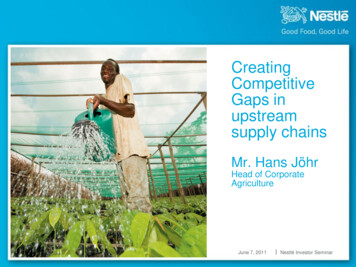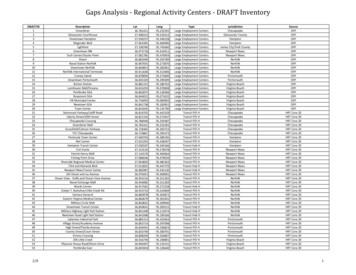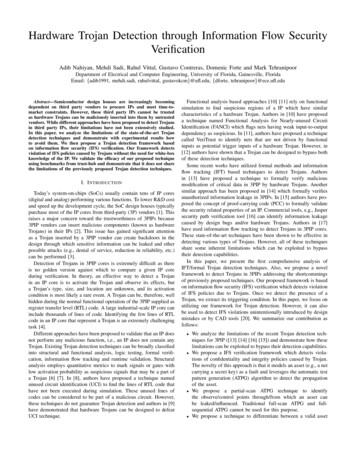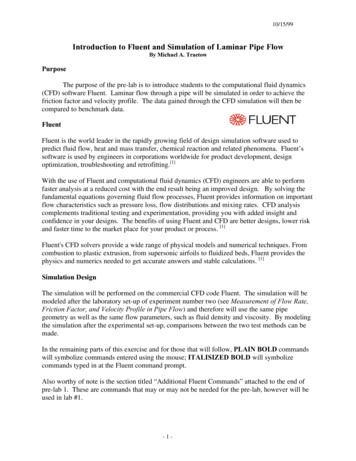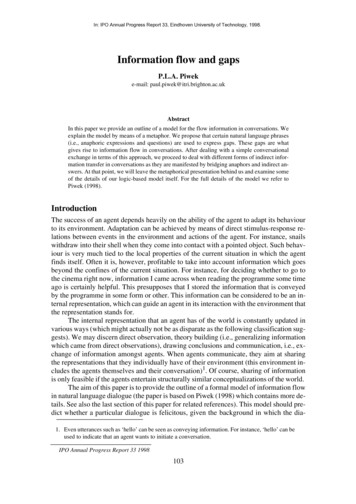
Transcription
In: IPO Annual Progress Report 33, Eindhoven University of Technology, 1998.Information flow and gapsP.L.A. Piweke-mail: paul.piwek@itri.brighton.ac.ukAbstractIn this paper we provide an outline of a model for the flow information in conversations. Weexplain the model by means of a metaphor. We propose that certain natural language phrases(i.e., anaphoric expressions and questions) are used to express gaps. These gaps are whatgives rise to information flow in conversations. After dealing with a simple conversationalexchange in terms of this approach, we proceed to deal with different forms of indirect information transfer in conversations as they are manifested by bridging anaphors and indirect answers. At that point, we will leave the metaphorical presentation behind us and examine someof the details of our logic-based model itself. For the full details of the model we refer toPiwek (1998).IntroductionThe success of an agent depends heavily on the ability of the agent to adapt its behaviourto its environment. Adaptation can be achieved by means of direct stimulus-response relations between events in the environment and actions of the agent. For instance, snailswithdraw into their shell when they come into contact with a pointed object. Such behaviour is very much tied to the local properties of the current situation in which the agentfinds itself. Often it is, however, profitable to take into account information which goesbeyond the confines of the current situation. For instance, for deciding whether to go tothe cinema right now, information I came across when reading the programme some timeago is certainly helpful. This presupposes that I stored the information that is conveyedby the programme in some form or other. This information can be considered to be an internal representation, which can guide an agent in its interaction with the environment thatthe representation stands for.The internal representation that an agent has of the world is constantly updated invarious ways (which might actually not be as disparate as the following classification suggests). We may discern direct observation, theory building (i.e., generalizing informationwhich came from direct observations), drawing conclusions and communication, i.e., exchange of information amongst agents. When agents communicate, they aim at sharingthe representations that they individually have of their environment (this environment includes the agents themselves and their conversation)1. Of course, sharing of informationis only feasible if the agents entertain structurally similar conceptualizations of the world.The aim of this paper is to provide the outline of a formal model of information flowin natural language dialogue (the paper is based on Piwek (1998) which contains more details. See also the last section of this paper for related references). This model should predict whether a particular dialogue is felicitous, given the background in which the dia1. Even utterances such as ‘hello’ can be seen as conveying information. For instance, ‘hello’ can beused to indicate that an agent wants to initiate a conversation.IPO Annual Progress Report 33 1998103
In: IPO Annual Progress Report 33, Eindhoven University of Technology, 1998.logue is conducted. On the basis of our functional view on the role of information, we canformulate an a priori constraint on our model of information flow: information flowshould not destroy the representational nature of the information. If this representationalnature is lost, the information can no longer help the agent to adapt to its environment.At this point, logic, i.e., the study of correct reasoning, comes into the picture. Logicconcerns precisely the manipulation of information without loss of its representational nature: an argument is logically valid only if the truth of premises carries over to the truthof the conclusion. We shall see that logic is not only on a priori grounds a good candidatefor modelling information flow, but also provides an adequate model for the data of natural language use.We will proceed as follows. We start by providing a metaphorical account of information flow. This account is developed by discussing a very simple example. Subsequently, we discuss some of the details of the underlying formal model. This enables us to provide an outline of our account of ‘indirect’ information flow in discourse. The main aimwill be to show that logic provides the proper handle to deal with that type of informationflow. Finally, we end with a summary and some references to further reading on the topicof this paper.Gaps and changing pools of informationTo speak of information flow would be somewhat gratuitous if there were not some outstanding characteristics that information shares with other things that can flow, such as,say, water, tea, or coffee. The model of information that we propose includes such a characteristic. Like a liquid, information can be thought of as flowing from higher to lowerplaces; in particular, it flows into informational gaps. This analogy between informationand liquids should become clearer after we have introduced the notion of an informationalitem.Informational itemsAn informational item consists of an object, and this object carries its type with it. Thus,instead of writing o, for some informational object, we write o : t, where t is the type ofthe object o. The type should be thought of as part of a conceptualization of the externalworld, i.e., the domain of interpretation of the informational items. The presence of an object of a certain type t in the agent’s information pool means to the agent that there existsan object in the external world which fits the type t. To make this more concrete, let ushave a look at a very simple body of information. The domain of interpretation for thispool of information is an electron microscope2. This pool of information contains fiveitems (to the right, we have added natural language paraphrases of each of the informational items):(1)abstu:::::lenslensc1 ac2 bexcited bthere is a lens, we refer to it with constant athere is a lens, we refer to it with constant ba is a c1 lensb is a c2 lensb is excited2. The example is taken from the DENK domain (see Bunt et al., 1998).104
In: IPO Annual Progress Report 33, Eindhoven University of Technology, 1998.In words: There are two lenses, a and b. They are different kinds of lenses: a is a c1 lens,and b is a c2 lens. Furthermore, b is excited (The light source in an electron microscopeis an electron gun. The microscope has electromagnetic lenses. By varying the currentthrough the lens, the magnification can be changed). Note that in our example, there arealso objects whose type is a proposition (e.g., u in u : excited b). Such an object standsfor the situation which would make the proposition true in the domain of interpretation.Simultaneously, the object functions as an internal proof/witness for the agent that theproposition holds.Information flow in dialogueA dialogue enables the interlocutors to share the information that their respective pools ofinformation contain. The information pool of an agent can be divided into the informationthat the agent believes to share with the other agent, let us call this its public information,and the information that the agent does not believe to share, i.e., its private information.In the course of a dialogue, private information is continually turned into public information. The prototypical conversational unit for doing so is a pair of utterances, such as aquestion followed by an answer. By means of a question, an interlocutor can specify whatinformation it would like to become public. The answer subsequently provides this information3. Consider:(2)A : Which lens is excited?B : The c2 lens (is excited).We will examine this exchange in detail by assigning a pool of information to each of theinterlocutors at the outset of the exchange, and then study how their utterances cause thatinformation to start flowing. At the beginning of the dialogue, interlocutor B has the information pool under (1). Additionally, assume that in B’s pool of information, the information that there is a c1 and a c2 lens is considered to be public, whereas the informationthat the c2 lens is excited is private.So, let us examine A’s utterance from B’s perspective. A’s utterance can be seen aspresenting an informational gap to B. This gap has to be filled with a lens which is excited.Formally, such gaps can be expressed by means of a so-called segment:(3)X : lens, S : excited XThe bold faced X stands for the gap that needs to be filled. Note that there is another gap,S, which also needs to be filled. The latter gap has to be filled with a proof for the proposition that the filler of X is excited. However, there is a crucial difference between X andS: whereas the person who posed the question is interested in the identity of the filler ofX, the identity of S is irrelevant4. The pool of information which is associated with B doesindeed provide the information to fill these gaps:3. For the purpose of this paper, we make the simplifying assumption that the person who answersthe question is known, by the interlocutors, to be an expert on the topic of the question. This causes the answer to become shared information. For a more sophisticated model of how informationcomes to be shared, see, e.g., Piwek (1998).105
In: IPO Annual Progress Report 33, Eindhoven University of Technology, 1998.(4)a : lensb : lenss : c1 at : c2 bu : excited bpublicexcited lensHere, we have used a pictorial representation for the gaps X and S. Each gap has, what wemight call, a filter associated with it. The filter is written below the gap and determineswhich objects are allowed into the gap. In this case, the gaps S and X are filled with theobjects u and b, respectively. We already pointed out that from the questioner’s point ofview only the filler of gap X is of interest: this filler stands for the lens which is excited.At this point, the task for B is to communicate to A that the object which b represents isexcited.If B has a correct representation of the public information, then A’s representationof the public information will also contain an object for the c1 lens and an object for thec2 lens:(5)cdvw::::lenslensc1 cc2 dB’s response (‘the c2 lens is excited’) can be seen as being composed of two parts: theidentification of an object (‘the c2 lens’) and the assertion that this object is excited. Theidentification of the object is achieved by means of a gap; ‘the c2 lens’ corresponds to:(6)Y : lens, T : c2 YThe fillers for the gaps Y and T are d and w, respectively. Secondly, B’s utterance containsnew information about the object d. Assuming that in this conversation B is an expert onlenses, A and B will make the proposition that this lens is excited public information. Bcan achieve this by simply moving ‘u : excited b’ from its private to its public information. In the case that A was asking a genuine question (i.e., not an exam question or a rhetorical question), A’s private information did not yet contain a proof for the fact that d isexcited. Therefore, A has to add a fresh proof for that proposition to its representation ofthe public information. In summary, after the exchange in (2), the public information hasbeen updated with the information that the c2 lens is excited.4. S needs to be filled with an object which stands for a situation, i.e., the situation in virtue of whichexcited x (for some object x) is true. If excited x is true, there is exactly one such situation. Thus,the identity of that situation cannot be something which the questioner is interested in.106
In: IPO Annual Progress Report 33, Eindhoven University of Technology, 1998.Logic and indirect informationIn order to deal with more complicated cases of information flow, we need to introducesome formal notation. Let ΓΑ and ΓΒ stand for the pools of information of A and B, respectively. Now, reconsider (4). There we provided a pictorial representation of the fillingof two gaps, i.e., X and S in the segment X : lens, S : excited X. Henceforth, we will writethe following to state that the gaps in a segment Δ can be filled given some pool of information Γ:(7)There is a substitution [σ] such that: Γ - Δ [σ]A substitution [σ] is an assignment of objects to the gaps in a segment. For instance, thesubstitution that is represented in (4) is written [X : b, S : u]. In its entirety (4) corresponds to:(8)ΓΒ - X : lens, S : excited X [X : b, S : u].If we carry out the substitutions in (8) we obtain:(9)ΓΒ - b : lens, u : excited bLogic enters the picture through the relation ‘ - ’. Alternative ways to read ‘Γ - C’ are: ‘Ccan be derived in Γ’ and ‘C is deducible from Γ’. In the examples that we presented uptill now, something could be deduced from a pool of information if it was literally presentin that pool of information. Logic, however, also allows us to make information that isimplicitly present explicit. Consider, for instance, the following two pieces of information:(10)(a) If Mary’s car is in the garage, then she is at home.(b) Mary’s car is in the garage.A pool of information which contains these two pieces of information, implicitly containsthe information that Mary is at home. If we abbreviate the propositions expressed by(10.a) and (10.b) as ‘p q’ and ‘p’, respectively, then the formal representations of thecorresponding informational items are:(11)(a) f : (p q)(b) a : pIn other words, there is a proof f for the proposition (p q) and a proof a for the proposition p. A proof for (p q) corresponds to a function which yields a proof for q when itis applied to a proof for p. Thus, f can be used to obtain a proof for q by applying f to a.This way, we obtain the proof f a for q (where ‘ ’ stands for function application). In otherwords, a proof for ‘Mary is at home’ can be constructed from the information that is conveyed by (10.a) and (10.b).PresuppositionWhen we dealt with the utterance of ‘The c2 lens is excited’, we pointed out that ‘the c2lens’ gives rise to a gap which has to be filled with an object from the public information.107
In: IPO Annual Progress Report 33, Eindhoven University of Technology, 1998.We pointed out that the identification of this object is separate from the assertion that isperformed by uttering ‘The c2 lens is excited’. This observation goes back to Frege(1892), one of the founding fathers of modern logic, who pointed out that negation doesnot affect the information that is conveyed by a definite description such as ‘the c2 lens’:(12)The c2 lens is not excited.Whereas the negation does reverse the assertion, (12) still requires that the public information contains a c2 lens. Expressions whose interpretations behave this way are calledpresuppositions. Let us now look at some properties of presuppositions, which nicely fitinto the model of information flow that we have proposed.We start by an examination of presuppositions in conditionals. Compare the discourse in (13.a) and (13.b):(13.a)John has a bottle of Châteauneuf-du-Pape. He keeps it in his wine cellar. The bottle is twelve years old.(13.b)(?) If John has a bottle of Châteauneuf-du-Pape, then he keeps it in his wine cellar. The bottle is twelve years old.The two question marks indicate that the discourse in (13.b) is intuitively felt to be anomalous as opposed to the felicitous discourse in (13.a), which differs only slightly from(13.b). The difference between (13.a) and (13.b) is that in (13.b) the object which is presupposed by the utterance of ‘the bottle’ is introduced in the antecedent of a conditional(i.e., ‘If John has a bottle of Châteauneuf-du-Pape’). It seems that this object is not accessible for reference in the sentence which follows the conditional. Note, however, that thebottle is accessible from the consequent of the antecedent, as is witnessed by the fact thatthe description ‘the bottle’ in (14) picks the object which is introduced as ‘a bottle of Châteauneuf-du-Pape’:(14)If John has a bottle of Châteauneuf-du-Pape, then he keeps the bottle in his winecellar.We model the judgments concerning (13) and (14) by positing that an object which is introduced in the antecedent of a conditional is not added to the public information, but rather treated as a hypothetical extension of the public information. This hypothetical extension is only used for the interpretation of the consequent of the conditional. Therefore, theobject is no longer accessible in the discourse that succeeds the conditional.The felicity of (13.a) requires no further explanation. It follows from our approachto presuppositions as it has been sketched in the previous section. So, let us turn to (14).The structure of (14) can be represented as:(15)P QπHere, π stands for the gap that is induced by the description ‘the bottle’ (formally wewrite: [X : object, P : bottle X]). According to our approach, π has to be filled with respectto Γ (the public information of the information pool of the interpreter) extended with P,108
In: IPO Annual Progress Report 33, Eindhoven University of Technology, 1998.i.e., a substitution S is required such that:(16)Γ, P - π [S]There is indeed such a substitution. This substitution assigns the object that is introducedby ‘a bottle of Châteauneuf-du-Pape’ in P, to the gaps in π. Now compare this with theinterpretation of the last sentence in (13.b). It has to be interpreted with respect to Γ only.Γ does not contain the introduction of a bottle, which is presupposed by the utterance of‘the bottle’ in the last sentence. Hence, the infelicity of the discourse.Let us now consider another small discourse, which provides further evidence forthe role of logical inference in information flow (the example is taken from Kamp andReyle, 1993, p.205):(17)(a) The barn contains a chain saw or a power drill.(b) It makes an ungodly racket.Intuitively, ‘It’ in (17.b) refers to a machine, whether it be a chain saw or a power drill,which is present in the barn that has been introduced in (17.a). Now, the problem is thatsuch a machine has not been mentioned explicitly in the first sentence of (17.a). We willshow that the information about the machine is, however, implicit in the information thatis conveyed by (17.a) and can be made explicit by means of logical inference and the useof some world knowledge.The piece of world knowledge that is required to interpret ‘It’ in (17.b) is that chainsaws and power drills are machines. This piece of world knowledge is public informationand can, therefore, be used by an interpreter of (17). Thus, we assume that the public information of a pool of information contains more than solely the information which hasbeen exchanged in the current discourse. It also contains all information which can reasonably be assumed to be public on the basis of the fact that the interlocutors are membersof the same community of language users.In order to demonstrate the logical inference from the explicit information conveyedby (17.a) to the implicit information, we need to introduce some abbreviations:(18)p There is a chain saw in the barn.q There is a power drill in the barn.r There is a machine in the barn.Now let us first restate the world knowledge that is needed:(19)(a) p r(b) q rThe content of (17) itself is p or q. Our aim is to prove that r holds. We proceed as follows.We assume that r does not hold (i.e., not r) and proceed to prove that this assumption leadsto a contradiction. From that, we conclude that r does hold (this patterns of logical argumentation is called the reductio ad absurdum). So, assume that not r. From (19.a) and notr, it follows that not p (this inference step is called contraposition). Similarly, from (19.b)and not r, it follows that not q. From (17) and not q, we can prove that p. Note that we had109
In: IPO Annual Progress Report 33, Eindhoven
1. Even utterances such as ‘hello’ can be seen as conveying information. For instance, ‘hello’ can be used to indicate that an agent wants to initiate a conversation. IPO Annual Progress Report 33 1998 In: IPO Annual Prog



